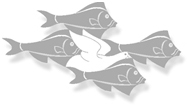

|
|
|
|
N. Rudaz
Ph.D. dissertation, under the supervision of Prof. R.D. Hersch, Thesis No 2757 presented at the Computer Science Department, Ecole Polytechnique Fédérale de Lausanne, May 2003
Electronic imaging devices produce the illusion of synthesizing continuous colors by applying halftones, which are repetitive structures of discrete micro-elements. By themselves, these microstructures do not carry any meaning: their only purpose is to fool the eye. We explore a new approach for creating color images with two layers of information, one layer of information being the global image and the second layer of information being represented by a meaningful microstructure embedded within the global image. When seen from far away, only the global image should be visible. From a close viewing distance, the microstructure should provide a clear visual impact.
A microstructure is incrusted into a color image by synthesizing chromatic differences between the foreground and background of the microstructure shapes. When viewed from a large distance, microstructure shapes embedded in the global image should not be distinguishable by the human eye. The resulting perceived color should be a combination of foreground and background colors, weighted by their respective surfaces. We have much freedom in creating chromatic differences expressed in terms of lightness, saturation or hue difference components.
The first problem consists in creating continuous chromatic differences within a 3D color space. A second problem is the creation of perceptually similar chromatic differences across the color space. A further problem resides in determining the local coverage percentages of the microstructure’s foreground and background, in order to appropriately choose their respective colors so as to ensure that when viewed from a certain distance, the combination of foreground and background appears as the desired target color.
The tools we created allow without much technical efforts to create global images incorporating freely designed or scanned bi-level microstructures. They may be used for advertisement as well as for creating huge posters incorporating artistically designed microstructures such as text, logos, and ornaments. In addition, the incrustation of characters and numbers into valuable document images (e.g. photographs in ID cards) provides a protection against counterfeiting attempts. The incrustation of such information can be specifically adapted to each instance of a security document, increasing its resistance against falsification by substitution.
Download the full paper: PDF 8.12 MB
![]()
![]()
![]()
![]()
![]()